EUROPEAN
HIGH SPEED TRAINS
TGV, ICE, AVE - Alphabet of Europe Fast Rail Travel
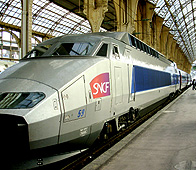 Japan
was the first country to come up with a practical high speed passenger
train, first begun development in 1959 and starting service in 1962,
nicknamed the “Bullet Train” not only for its speed, but
for its round nose which rather looked like a bullet. Soon, the idea
of rapid travel by rail caught on in Europe, with an already extensive
rail network in common use, which could be adapted to high speed travel
with various designs resulting. The French followed with the TGV, initials
standing for “très grande vitesse“ or very high speed.
Originally it was to be Turbine Grand Vitesse, because the proposed design
was going to use a turbine engine, essentially a jet train, but by the
time it came into being with the rise of fuel prices in the 1970s, it
was changed to electric. All European high speed trains are now electric.
After the TGV came online, next was the German ICE in 1991, “Inter
City Express". Then, the Eurostar between London and Paris (see Eurostar
Chunnel London to Paris) requiring a tunnel under the English channel
and a dedicated rail line, adding Brussels later. The Thalys line is
a separate
line running directly between Paris, Brussels, Liege and Cologne, with
a line to Antwerp and Amsterdam (see Thalys High Speed Red Bullet). Spain now has the AVE “Alta Velocidad
Española” and in Italy the high speed train is Eurostar
Italia.
Japan
was the first country to come up with a practical high speed passenger
train, first begun development in 1959 and starting service in 1962,
nicknamed the “Bullet Train” not only for its speed, but
for its round nose which rather looked like a bullet. Soon, the idea
of rapid travel by rail caught on in Europe, with an already extensive
rail network in common use, which could be adapted to high speed travel
with various designs resulting. The French followed with the TGV, initials
standing for “très grande vitesse“ or very high speed.
Originally it was to be Turbine Grand Vitesse, because the proposed design
was going to use a turbine engine, essentially a jet train, but by the
time it came into being with the rise of fuel prices in the 1970s, it
was changed to electric. All European high speed trains are now electric.
After the TGV came online, next was the German ICE in 1991, “Inter
City Express". Then, the Eurostar between London and Paris (see Eurostar
Chunnel London to Paris) requiring a tunnel under the English channel
and a dedicated rail line, adding Brussels later. The Thalys line is
a separate
line running directly between Paris, Brussels, Liege and Cologne, with
a line to Antwerp and Amsterdam (see Thalys High Speed Red Bullet). Spain now has the AVE “Alta Velocidad
Española” and in Italy the high speed train is Eurostar
Italia.
Fastest
Trains
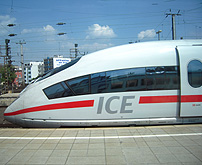 The
fastest high speed train in Europe is the French TGV, (though the current
world’s fastest train is now in China). The French design,
though a bit more boxy looking in appearance, can go somewhat faster
than the German ICE due to the double carriage design, where the connecting
cars share
the
same
wheels
or “bogie” allowing
for more stability, where on the German DB ICE, each coach is an individual
unit. Where the TGV has the advantage of a bit more speed, the ICE
can more easily adjust the composition of the trains for more routes
and
varying passenger loads.
The
fastest high speed train in Europe is the French TGV, (though the current
world’s fastest train is now in China). The French design,
though a bit more boxy looking in appearance, can go somewhat faster
than the German ICE due to the double carriage design, where the connecting
cars share
the
same
wheels
or “bogie” allowing
for more stability, where on the German DB ICE, each coach is an individual
unit. Where the TGV has the advantage of a bit more speed, the ICE
can more easily adjust the composition of the trains for more routes
and
varying passenger loads.
How fast
do the high speed trains go?
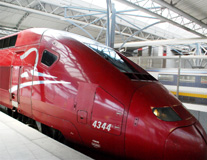 How
fast do the high speed trains go? The TGV record speed in 2007 was
357 miles per hour. The trains rarely travel at maximum speeds in
service. The TGV tops out just under 200 miles an hour (320 kph)
on operational
routes. China is working on a 400 kph train. The ICE trains reach up to
around 175 mph, though typically travel at somewhat less. You can watch
the speedometer
provided at the end of the coach where 280 kph is about what you'll
see at the
top end. Depending how far the journey is between stations and how
populated the area, the speeds will vary. Ultimately, you may not notice
the difference.
High speed trains have sealing doors to keep the air pressure stabilized
so the ride is smooth and comfortable and may not seem that much
faster than some regular trains. Most of the high speed trains have
restaurant
cars and both first class and second class service. Some require
reservations, others do not, though reservations are advisable on
long travel routes.
If buying a single trip ticket for either first class or second class,
the reservation is of course included.
How
fast do the high speed trains go? The TGV record speed in 2007 was
357 miles per hour. The trains rarely travel at maximum speeds in
service. The TGV tops out just under 200 miles an hour (320 kph)
on operational
routes. China is working on a 400 kph train. The ICE trains reach up to
around 175 mph, though typically travel at somewhat less. You can watch
the speedometer
provided at the end of the coach where 280 kph is about what you'll
see at the
top end. Depending how far the journey is between stations and how
populated the area, the speeds will vary. Ultimately, you may not notice
the difference.
High speed trains have sealing doors to keep the air pressure stabilized
so the ride is smooth and comfortable and may not seem that much
faster than some regular trains. Most of the high speed trains have
restaurant
cars and both first class and second class service. Some require
reservations, others do not, though reservations are advisable on
long travel routes.
If buying a single trip ticket for either first class or second class,
the reservation is of course included.
TGV - France Très Grande Vitesse
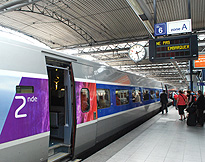 The
TGV, operated by the SCNF French National Railway, runs within
France (and Belgium to Brussels and some Germany stations), with connections
to other countries from terminus cities. The system was developed with
Paris
as
a hub
and
routes
radiating
to other cities through France. The first line was between Paris
and Lyon,
still the most popular route, running from Paris through Dijon (see Dijon
Rail Central Hotels) to Lyon, Avignon and Nice on the
French Riviera (see Nice
Comfort Hotels), with a branch line to Marseilles . The
TGV Est (East) completed in 2009 runs from Paris to Strasbourg or
Basel
with connections to
the German DB or Swiss SBB, (see TGV Lyria Paris to Switzerland). The Eurostar terminal from London or Brussels
is Paris Nord. The TGV lines in Paris operate from different stations.
Paris Est station is a few blocks from the Paris Nord Station on
the northeast of central Paris. Or the Paris Gare Lyon station for
the lines
to the south which requires a Metro or taxi transfer from Paris Nord.
With a Eurail Rail Pass or Interrail, the TGV does not strictly require
a reservation, but advisable on the high traffic routes and especially
for long distances.
The
TGV, operated by the SCNF French National Railway, runs within
France (and Belgium to Brussels and some Germany stations), with connections
to other countries from terminus cities. The system was developed with
Paris
as
a hub
and
routes
radiating
to other cities through France. The first line was between Paris
and Lyon,
still the most popular route, running from Paris through Dijon (see Dijon
Rail Central Hotels) to Lyon, Avignon and Nice on the
French Riviera (see Nice
Comfort Hotels), with a branch line to Marseilles . The
TGV Est (East) completed in 2009 runs from Paris to Strasbourg or
Basel
with connections to
the German DB or Swiss SBB, (see TGV Lyria Paris to Switzerland). The Eurostar terminal from London or Brussels
is Paris Nord. The TGV lines in Paris operate from different stations.
Paris Est station is a few blocks from the Paris Nord Station on
the northeast of central Paris. Or the Paris Gare Lyon station for
the lines
to the south which requires a Metro or taxi transfer from Paris Nord.
With a Eurail Rail Pass or Interrail, the TGV does not strictly require
a reservation, but advisable on the high traffic routes and especially
for long distances.
Rail Europe TGV France High Speed
ICE - Germany Inter City Express
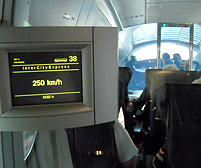 The
German ICE trains operate between all the major cities in Germany with
no centralized hub. They all run on the same tracks and routes
as the standard rail trains of the DeutschBahn. Some ICE train routes
carry
into neighboring countries, several routes in Switzerland, (see Tour
the Rhine by Rail Pass), Belgium and the Netherlands
(see Benelux
By Rail Pass). The ICE trains run on regular schedules
throughout the day, about every two hours on some routes and once
an hour
at rush
hour
between
some
cities. ICE trains
have electrical outlets for laptops and some are wireless connected.
The
German ICE trains operate between all the major cities in Germany with
no centralized hub. They all run on the same tracks and routes
as the standard rail trains of the DeutschBahn. Some ICE train routes
carry
into neighboring countries, several routes in Switzerland, (see Tour
the Rhine by Rail Pass), Belgium and the Netherlands
(see Benelux
By Rail Pass). The ICE trains run on regular schedules
throughout the day, about every two hours on some routes and once
an hour
at rush
hour
between
some
cities. ICE trains
have electrical outlets for laptops and some are wireless connected.
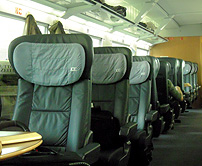 The
ICE generally doesn’t require
a reservation for Eurail rail pass holders (though some international
trains do need a reserved seat and will have a note on the schedule
board). First Class seats
will be readily available
throughout
the
day, but
can fill up at rush hours with business commuters. Most ICE trains
do not
require any additional costs for rail pass holders, though some
trains at rush hours may require a supplement, which can be paid at a
ticket
office or to the conductor. If traveling on an ICE Train with some
form of rail pass and no reservation, look for the reservation
indicator above
the seat, most are now electronic. If
there is a city pair next to the seat number like "Frankfurt-Berlin" that
means the seat is reserved for that section of the route, but available
the other parts of the route. You may sit in the seat until the
train reaches the city indicated, then would
have
to move to another open seat. If the indicator is blank that means
the seat is open. There is space for luggage on racks above the
seats, but on some trains the overseat racks can be a bit narrow
in height.
There are baggage racks
for larger suitcases at the ends of the cars or some room between
the seats. (see Germany's
ICE Fast Train).
The
ICE generally doesn’t require
a reservation for Eurail rail pass holders (though some international
trains do need a reserved seat and will have a note on the schedule
board). First Class seats
will be readily available
throughout
the
day, but
can fill up at rush hours with business commuters. Most ICE trains
do not
require any additional costs for rail pass holders, though some
trains at rush hours may require a supplement, which can be paid at a
ticket
office or to the conductor. If traveling on an ICE Train with some
form of rail pass and no reservation, look for the reservation
indicator above
the seat, most are now electronic. If
there is a city pair next to the seat number like "Frankfurt-Berlin" that
means the seat is reserved for that section of the route, but available
the other parts of the route. You may sit in the seat until the
train reaches the city indicated, then would
have
to move to another open seat. If the indicator is blank that means
the seat is open. There is space for luggage on racks above the
seats, but on some trains the overseat racks can be a bit narrow
in height.
There are baggage racks
for larger suitcases at the ends of the cars or some room between
the seats. (see Germany's
ICE Fast Train).
Example Travel Times between cities on the ICE
Munich to Hamburg - 6 hours
Hamburg to Frankfurt - 3 hours 35 minutes
Cologne to Berlin - 4 hours 20 minutes
Stuttgart-Dusseldorf - 2 hours 40 minutes
Rail
Europe ICE Tickets
Thalys
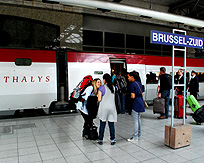 The
Thalys is a high speed train running from Paris to Brussels, then to
Cologne via Liege (see Liege-Guillemins)
or to Amsterdam via Antwerp, with stops on 17
cities in all. The Thalys used the same train equipment as
the TGV but recognized
by its distinctive Crimson and Silver paint scheme, sometime
just call the "red train". You can get a special discount
fare on the Thalys if you make a connection in Brussels on
a SNCB (Belgian Rail)
train to another stop in Belgium. not served by the Thalys
directly, like Bruges (see Halve
Mann Brewery), Ghent, Ypres or Mons (Romantic
Mons).
The
Thalys is a high speed train running from Paris to Brussels, then to
Cologne via Liege (see Liege-Guillemins)
or to Amsterdam via Antwerp, with stops on 17
cities in all. The Thalys used the same train equipment as
the TGV but recognized
by its distinctive Crimson and Silver paint scheme, sometime
just call the "red train". You can get a special discount
fare on the Thalys if you make a connection in Brussels on
a SNCB (Belgian Rail)
train to another stop in Belgium. not served by the Thalys
directly, like Bruges (see Halve
Mann Brewery), Ghent, Ypres or Mons (Romantic
Mons).
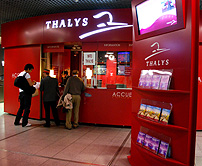 The
Thalys has reclining seats with audio and music programs to relax while
racing across the flat plains of Northern France
and Belgium,
with a Bistro Restaurant car and trolley snack service. The
Thalys Train
does require a reservation with or without a rail pass. Main
Stations on the Thalys route have their own distinctive ticketing
booths, though
tickets can be purchased online or at regular rail ticket windows.
The Thalys train departs and arrives in Paris from the same
station as the
Eurostar,
Paris
Nord, so requires no cross Paris transfer, like the TGV.
Though if one were traveling between Brussels and London,
without needing
to stop
in
Paris, the Eurostar offers a direct route London-Brussels.
In Brussels, the Thalys, TGV and ICE trains stop at the Brussels
Zuid (South) Station.
The
Thalys has reclining seats with audio and music programs to relax while
racing across the flat plains of Northern France
and Belgium,
with a Bistro Restaurant car and trolley snack service. The
Thalys Train
does require a reservation with or without a rail pass. Main
Stations on the Thalys route have their own distinctive ticketing
booths, though
tickets can be purchased online or at regular rail ticket windows.
The Thalys train departs and arrives in Paris from the same
station as the
Eurostar,
Paris
Nord, so requires no cross Paris transfer, like the TGV.
Though if one were traveling between Brussels and London,
without needing
to stop
in
Paris, the Eurostar offers a direct route London-Brussels.
In Brussels, the Thalys, TGV and ICE trains stop at the Brussels
Zuid (South) Station.
Example Times between cities on the Thalys
Paris to Brussels - 1 hour 17 minutes
Paris to Amsterdam - 3 hours 18 minutes
Amsterdam to Brussels - 1 hour 53 minutes
Brussels to Cologne - 1 hour 47 minutes
Paris to Cologne - 3 hours 14 minutes
Rail
Europe Thalys High Speed
AVE
- Spain Alta Velocidad Española
Spain's AVE High Speed Train operates between the country's larger cities,
Madrid, Seville, Malaga and Barcelona. The AVE is the most recent of
the high speed rail designs reaching speeds up to 186 mph and operates
on standard gauge track, where most of the Spanish rail network is
a broad gage. This was chosen so that the AVE could run in other European
countries in the future like the ICE does. Currently the AVE does not
directly connect with France, but a tunnel project through the Pyranees
is underway with a connecting route from Barcelona to Montpellier in
France expected to open in 2012. The AVE offers an on time arrival
guarantee on some routes as Spanish RENFE state rail trains can be
a little casual on the schedule.
Rail Europe AVE High Speed Spain
Railjet Austria
Austria OBB has a high speed system that travels within the borders and across Europe
Rail Europe Austria RailJet High Speed
Eurostar
Italia - Italy Alta Velocità
Trentalia, the Italian State Railway operates the Eurostar Italia
AV (Alta Velocità) throughout Italy on standard track routes with
the same equipment as British-French Eurostar. The long "boot" of
Italy is ideal for a high speed rail. Travel to Rome, Florence,
Venice, Milan, Bologna or Naples with the stunning scenery of
vineyards and
ancient towns in stress-free comfort.
Reservations are compulsory on the Eurostar Italia, with a 10 Euro
suppliment for both first class and second class passagers holding
a Eurail Pass.
First class reservations include snack and a hot or cold drink served
at your seat and on morning trains a daily newspaper is offered.
Advance purchase discounts are available on the Italia Eurostar.
Example Travel Times in Italy on Eurostar Italia
Milan to Bologna - 1 hour 5 minutes
Milan to Venice - 2 hours 20 minutes
Rome to Milan - 3 hours 30 minutes
Rome to Venice - 3 hours 59 minutes
Rome to Naples - 1 hour 21 minutes
The Cisalpino
The Italian Cisalpino is a tilting train which operates between Northern
Italy, Switzerland and Germany. Not an especially high speed train, its
tilting action allows it to travel faster through the mountains. A trip
from Milan to Basel takes about 4 hours and 30 minutes. The Cisalpino
is being updated with newer equipment.
Switzerland ICN
Switzerland only has high speed trains on limited routes.
They do have
am "N"'
train which like the Cisalpino allows the cars to tilt on the carriages
so the train can take curves at
higher speed,
allowing
them to shorten some route times. The length of the journey except
between some major cities is not all that much faster, but the
ride
is
a
smoother (see Switzerland
By Rail Pass). High speed train lines like the ICE and TGV Lyria do operate in Switzerland
on specific routes, but travel at standard speeds for intercity trains. © Bargain
Travel Europe
Web
Info
Rail Europe Rail Passes
These articles are copyrighted and the sole property of Bargain Travel Europe and WLPV, LLC. and may not be copied or reprinted without permission.
See Also:
CITY NIGHT LINE - DRESDEN TO ZURICH
CULTURE CONNECT - LONDON-PARIS MUSEUMS 2 FOR 1 DEAL



